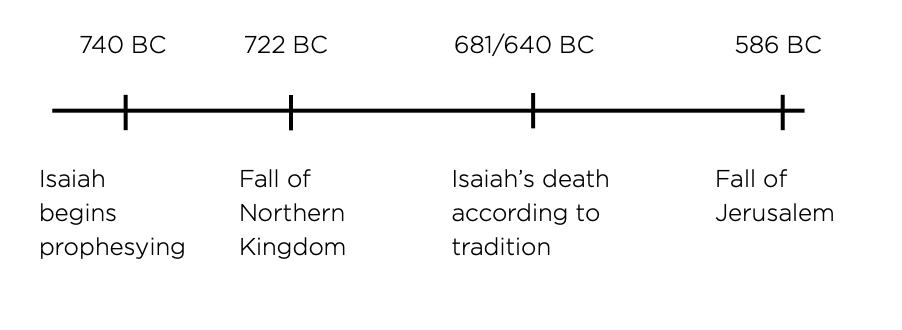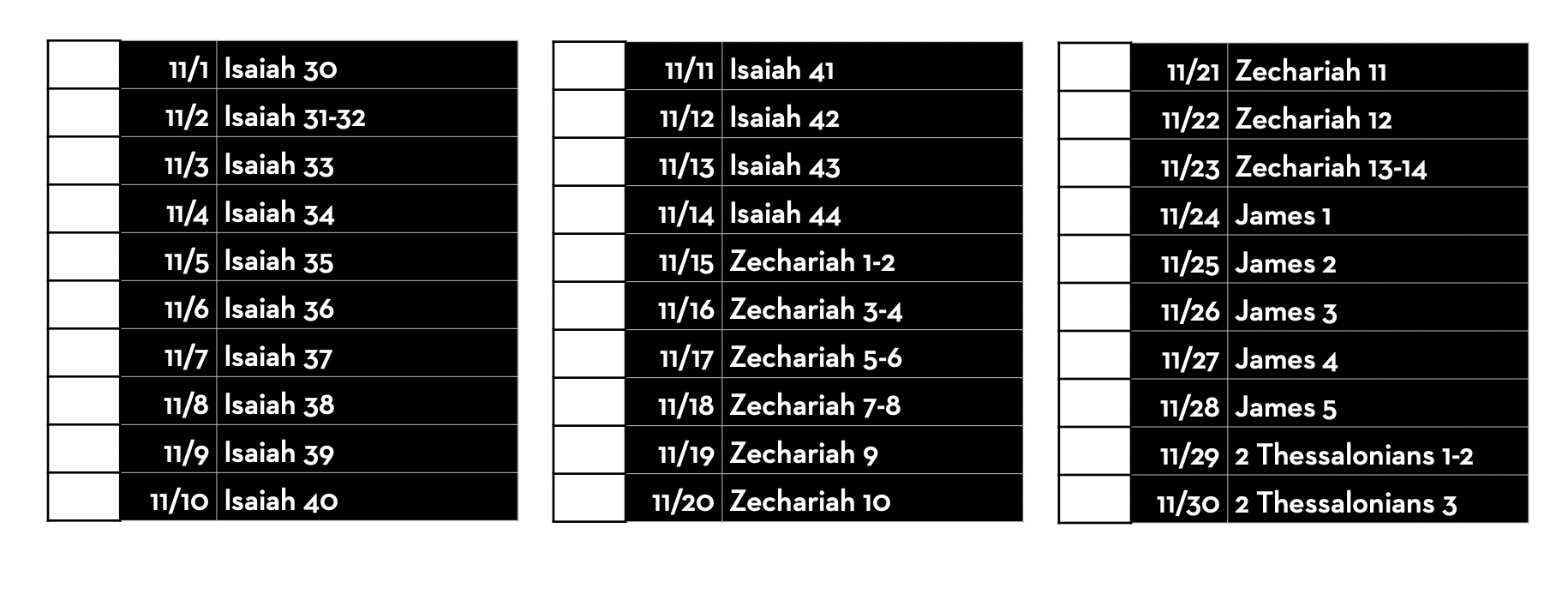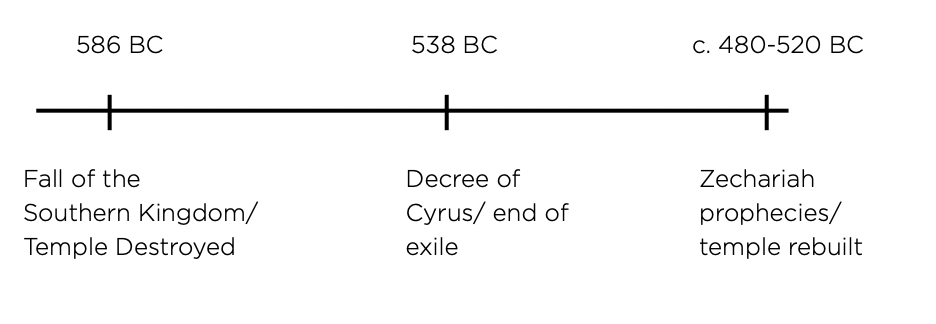November Bible Reading Plan
ISAIAH
Timeline (Approximate)

Authorship and Purpose:
The book of Isaiah contains the prophecies of the prophet Isaiah, who was called by God in the year of King Uzziah’s death. There is much debate among scholars about who exactly wrote the book and when it was written. That said, multiple books in the Bible identify Isaiah as the source for the prophecies contained in the whole book, and functionally the book works best as one unified whole rather than a compilation from different authors from different time periods. Further, the book of Isaiah carries with it the same authority as the other books of the Bible and is an indispensable book within the whole of Scripture.
By the time Isaiah began prophesying, Israel was well on the decline in the eyes of God. Though recently there had been relative prosperity in both kingdoms, there had also been injustice, idolatry, and lack of reliance on God. Through Isaiah, God announces His intention to pass judgment on His people for their sins if they do not repent. This judgment, however, is not without hope. There will be a future king who comes to bring about justice and restore Israel.
Reading Isaiah:
The book of Isaiah is the first of the major prophets in the Old Testament. It is filled with divine messages from God through Isaiah in the form of Hebrew poetry, with bits of narrative appearing in between. Remember that prophecy in its basic form is a message from God and prophets are essentially God’s elected spokesperson. These messages can contain future hopes, but also contain God’s message directly to Israel’s present circumstances.
Hebrew poetry is very different from the contemporary poetry we are used to reading and can be difficult to follow. Often, the ideas communicated within each line or phrase will “rhyme” with each other, meaning the author will link lines together by repeating or building on a singular idea. This repetition adds more layers to the word picture being painted by the author. Ultimately, poetry communicates best when it connects on an emotional level. Allow the pictures painted by the poetry to connect, be it the pictures of Israel’s sin, God’s wrath, or the hope offered in repentance. The book is long but has repeating themes which are possible to track.
This section of Isaiah starts with an accusation of Jerusalem’s leaders for making an alliance with Egypt because Isaiah knows this will fail them. We see the rise and fall of Jerusalem through King Hezekiah and his foolishness in creating yet another alliance that will eventually lead to the exile. Isaiah’s hope throughout the book is that the future Messiah will come and bring hope to the people.
Key Themes:
God is guiding all of human history.
The wrath of God is to be feared above all else.
Hold onto hope. The future is filled with hope, and God is fulfilling Isaiah’s prophecies. A Messiah is on the way.
The people have lost faith. God is responding to people’s faithlessness and gives them insight to why they are in suffering.
Structure:
- God’s Sovereign Word Spoken into the World (28-35)
- Historical Transition: “In Whom Do You Now Trust?” (36-39)
- Encouragement for God’s Exiles: “The Glory of the Lord Shall Be Revealed” (40–55)
ZECHARIAH
Timeline (Approximate)
Authorship and Purpose:
Zechariah was both a prophet and a priest. He was a prophet by calling and a priest by family lineage. He began his ministry shortly after Haggai had begun his prophetic work. He had an intimate familiarity with the worship practices of the Jews due to his priestly heritage, even if he had never served in a completed temple due to its destruction around 586 BC.
Zechariah’s name means “Yahweh remembers,” which was appropriate to the purpose of his prophecies. Zechariah is a book of hope and encouragement. It is a reminder that God would remember His promises to His people, even after all the time they had spent in exile. They would still be judged for sin, but God would bring cleansing and restoration, and God would rebuild his people and his temple.
The setting for this book is that a moral reformation of the people had not occurred. Jerusalem was still only partially rebuilt and had no significance among the surrounding nations. The people concluded that God was absent from them. Many viewed faithful obedience as useless. It seemed to make more sense to forget God and to pursue the best life possible.
Reading Zechariah:
The book of Zechariah contains the clearest and the largest number of messianic (about the Messiah) passages among the Minor Prophets. In that respect, it’s possible to think of the book of Zechariah as a kind of miniature book of Isaiah. Zechariah pictures Christ in both His first coming (Zechariah 9:9) and His second coming (9:10–10:12). Jesus will come, according to Zechariah, as Savior, Judge, and ultimately, as the righteous King ruling His people from Jerusalem (14:8–9).
The messianic prophecies were especially timely, because at the time God’s people were discouraged. The chapters of Zechariah are filled with dreams (prophecies) and commissions to repentance and faithfulness. It’s filled with the encouragement that a Messiah is coming, and that the people should ready themselves for his arrival.
Key Themes:
Repentance & Faithfulness - the call to turn away from sinful ways and return to the one true God.
Hope - God’s people are called to place their hope in Him, and be spiritually renewed.
The Advent of the Messiah - a Messiah is coming. Chris is predicted to come in lowliness and humanity. He’ll be rejected and struck down, but His kingship will not end. He is building an everlasting temple and will reign with peace and prosperity for God’s glory.
Structure:
- Eight visions and a call to repentance - (1-6)
- Four Messages about fasting and the future - (7-8)
- Two Oracles - (9-14)
-
- Rejection of the Messiah by Israel - (9-11)
- Messianic reign when Israel is delivered - (12-14)
JAMES
Timeline (Approximate)
Authorship and Purpose:
This letter was written by James, the half-brother of Jesus and leader of the Jerusalem church. It was probably written about A.D. 40–45 to Jewish Christians living outside Palestine.
James was likely not a follower of Chris during Jesus’ time on earth, but eventually became an apostle after he had seen and believed the Lord post-resurrection. After witnessing the Lord’s resurrected body, James became one of the leaders of the church at Jerusalem. Peter singled him out among the other Christians there following Peter’s miraculous release from prison. James made the deciding speech at the Jerusalem Council, and Paul called James one of the pillars of the church. He was also known as a peacemaker who led with wisdom and courage until he was murdered.
Reading James:
James’s readers were suffering persecution and living in poverty. They were in social and spiritual conflict. Many believers were living in a worldly manner. James corrects them and challenges them to seek God’s wisdom to work out these problems.
The book of James reads a lot like the wisdom in Proverbs. It’s filled with practical action for a faith-filled life. It’s written to encourage God’s people to act like God’s people. The pages of James are filled with direct commands to pursue a life of holiness. He tells the Christians of the early church to give evidence of their faith in Christ by living out a lifestyle worthy of their calling. He is famously known by his writing, “faith without works is dead.” He calls the church then (and now) to put action to their beliefs and walk it out. He also gives them a set of actions and character to avoid.
Key Themes:
Faith and works - The church is called to take action, live in a holy manner, and conduct themselves worthy to the calling Jesus gave them. James calls the believers to ask in accordance with their faith, and live fully aligned with the Gospel in the nature of Jesus.
Wisdom and religion - James calls the church to stand in the face of trial and temptation, and to seek wisdom, listen to wisdom, and act on wisdom.
Structure:
- The Testing of Faith & Responding to the Word - (1)
- The Sin of Favoritism - (2:1–13)
- Faith without Works Is Dead - (2:14–26)
- Things to avoid - Division and Discord, Misuse of Wealth - (3-5)
- Prayer & Encouragement - (5)
2 THESSALONIANS
Timeline (Approximate)
Authorship and Purpose:
Paul was a Jew that had persecuted the earliest Christians, and opposed the Jesus movement. He was well-versed and educated in all the Jewish customs and ways. Paul had a radical conversion to Christianity that can be recounted in Acts 8-9. He then went on to lead the early church, and spread the Gospel throughout the middle east and Asia.
Shortly after writing 1 Thessalonians, the apostle Paul received a report that the Thessalonian church had accepted the strange claim that “the day of the Lord has come”. Paul sent them a second letter to clarify the claims, and give the church renewed hope.
Reading 2 Thessalonians:
The church of Thessalonica, that had been founded by Paul, was fairly young. The Gospel had been presented to them, but after Paul abruptly left them due to opposition they were left with little support and training, and was under persecution.
Paul writes this letter to the church in response to hearing that the Thessalonians believed Jesus had either already come or was coming so soon that the church had decided to stop their daily living and simply wait for Jesus’ arrival. Paul assumes that the Thessalonian church knew that the second coming of Jesus Christ would occur at the same time as the coming of the “day of the Lord.” Yet the Thessalonians may simply have fallen victim to a belief that the day of the Lord had already come. The persecution they were undergoing may have fueled their confusion about the end times.
Paul takes the opportunity to speak to them bluntly about their bad theology and behavior. He simultaneously encourages them in right thinking and conduct, and assures them of the coming Savior’s arrival.
Key Themes:
Encouragement - to encourage them in their steadfastness under persecution.
Correction - To correct their misunderstanding about the imminence of the Lord's return.
Action - To instruct the congregation on what disciplinary action to take toward those who refused to work
Structure:
-
- Greetings & Thanksgiving - (1)
- Instruction on Jesus’ coming and Christian conduct - (2)
- Prayer and Warning - (3)
 DOWNLOAD NOVEMBER READING PLAN PDF
DOWNLOAD NOVEMBER READING PLAN PDF

